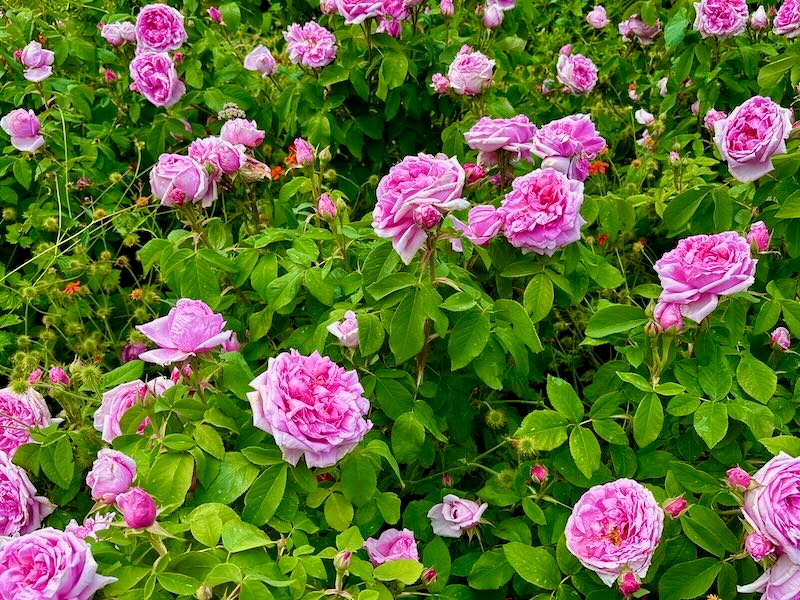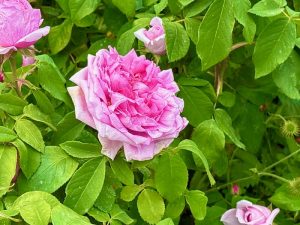Rosa ‘Comte de Chambord’: A Fragrant Heirloom with Lasting Charm
Rosa ‘Comte de Chambord’ or Comte de Chambord Rose is one of the most beloved Portland roses, cherished for its captivating Old Rose fragrance, repeat blooming habit, and vintage form. Introduced in 1860 by the French breeder Moreau-Robert, this classic rose continues to hold a revered place in gardens across the globe. It combines the nostalgic charm of antique roses with a performance that rivals many modern cultivars.
Rosa ‘Comte de Chambord’ belongs to the rose family, Rosaceae, one of the most well-known and widespread plant families in the world. This family includes not only ornamental roses, but also many important fruit-bearing plants like apples (Malus), cherries (Prunus), and strawberries (Fragaria). Within Rosaceae, the genus Rosa is prized for its beauty, fragrance, and cultural significance, with thousands of cultivars bred over centuries. As a classic Portland rose, ‘Comte de Chambord’ carries the defining traits of the family—elegant flowers, compound foliage, and a tendency to bloom generously with the right care.
This rose carries strong ties to the Old Garden Rose tradition, specifically the Portland group, which bridges the characteristics of Damask and Hybrid Perpetual roses. Gardeners treasure its medium-pink to light magenta blooms, which open in a classic quartered rosette. Each flower offers an opulent, true Old Rose scent that perfumes the garden and enriches any bouquet.
The Enduring Appeal of Rosa ‘Comte de Chambord’
The shrub grows upright and vigorous, reaching 4 to 5 feet (1.2–1.5 m) in height and spreading up to 3 to 4 feet (0.9–1.2 m) wide. The stems carry a notable amount of prickles, while the foliage emerges light green and slightly coarse in texture. Leaves rise close to the blooms, a trait typical of Portland roses.
Blooms are fully double, averaging 3 to 4 inches (7.5–10 cm) across, with a petal count around 55. They emerge in a rich, warm pink with magenta tones, sometimes showing a hint of lavender as they mature. This rose repeats reliably, with strong flushes from late spring through early fall, particularly thriving in cooler temperatures.
How to Grow Rosa ‘Comte de Chambord’
Light
Plant this rose where it will receive full sun for at least six hours a day. Morning sun is ideal to dry off dew and reduce the risk of fungal diseases. In hotter climates, some afternoon shade helps preserve bloom color and longevity.
Soil
Like most roses, ‘Comte de Chambord’ thrives in fertile, well-drained soil rich in organic matter. Amend the planting hole with compost or aged manure to encourage strong root growth.
Watering
Water deeply and regularly during the growing season. Keep the soil evenly moist but never soggy. Avoid overhead watering to minimize fungal issues. A soaker hose or drip irrigation is ideal.
Fertilizing
Feed in early spring with a balanced fertilizer formulated for roses. Apply again after the first major bloom flush. Stop feeding by late summer to allow the plant to prepare for dormancy.
Pruning
Prune in late winter or early spring. Remove dead, damaged, or weak wood first. Shape the shrub by cutting back strong shoots by one-third and shortening side shoots to two or three buds. Deadhead spent blooms throughout the season to encourage reblooming.
Mulching
Apply a 2–3 inch (5–8 cm) layer of organic mulch around the base of the plant. This helps retain soil moisture, suppress weeds, and regulate soil temperature.
Pests and Diseases
While generally resistant to disease, ‘Comte de Chambord’ benefits from good air circulation and proper spacing. Monitor for black spot, powdery mildew, and aphids. Treat early with insecticidal soap or fungicides if needed.
Propagation
This rose can be propagated by hardwood cuttings taken in late autumn or softwood cuttings in early summer. Select non-flowering shoots for the best success.
Landscape Uses
Perfect for mixed borders, rose gardens, or cottage-style plantings, ‘Comte de Chambord’ also makes an excellent cut flower. Its high petal count and strong fragrance lend themselves to fresh arrangements and potpourri.
Historical and Botanical Notes
The rose is often at the center of identity debates. Some sources claim that ‘Comte de Chambord’ is synonymous with ‘Mme. Boll’ or ‘Mme. Knorr’. Regardless of its true name, this rose has become an icon of the Portland class. Its legacy extends to modern rose breeding, most notably as a parent of the celebrated English Rose Rosa ‘Gertrude Jekyll’ by David Austin.
Its introduction in 1860 by Moreau-Robert places it in the rich lineage of 19th-century French hybridization, a period renowned for producing many of today’s cherished heritage roses.
Awards and Recognition
In 2022, ‘Comte de Chambord’ was honored with a place in the Old Rose Hall of Fame by the World Federation of Rose Societies. This accolade celebrates roses of historical and garden significance that have stood the test of time.
Final Thoughts
Few roses combine beauty, fragrance, and repeat flowering as gracefully as Rosa ‘Comte de Chambord’. Whether you grow it for its historical significance, its intoxicating scent, or its resilient performance, this rose offers an experience both romantic and rewarding. For any gardener seeking the charm of Old Roses with the vigor of modern shrubs, ‘Comte de Chambord’ is a rose worth planting—and cherishing for years to come.



